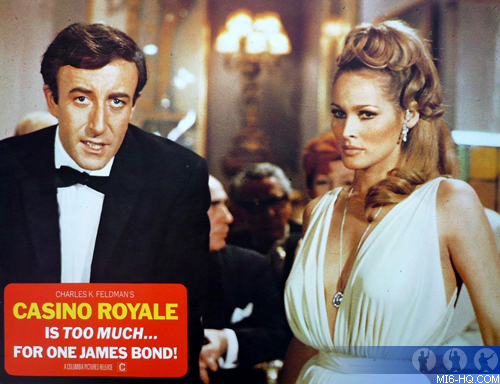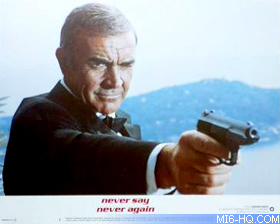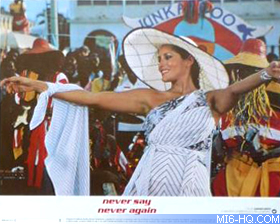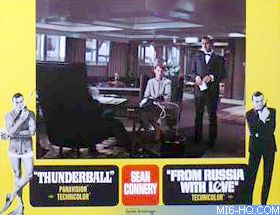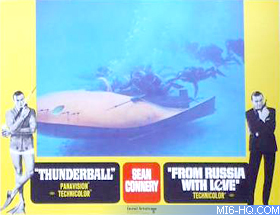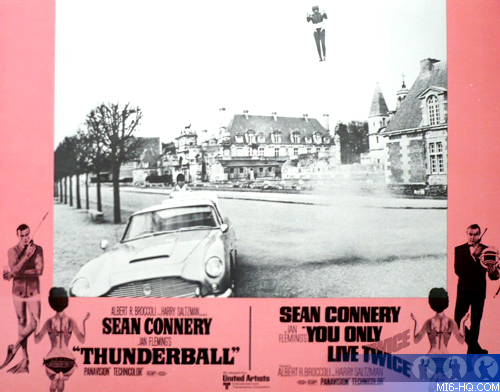Collecting 007 Lobby Cards (4)
30th November 2013
Guest writer Simon Firth offers a collector's perspective on the history of Bond's front of house marketing
 By Simon Firth
By Simon Firth
To go back through the years though, there are still a number of sets to be covered for this series. The 1967 'unofficial' "Casino Royale" produced a competent set, as did "Never Say Never Again". Both had full sized images, were produced in the US, and were sets of eight. However, as was earlier introduced to this essay a question mark over the provenance of two paper "For Your Eyes Only" sets as being possibly Australian, a further curio should be discussed in respect of an Australian photosheet for "Never Say Never Again". A 1-sheet poster sized collection of six b/w images against a red / gold coloured border with a banner effect image of the lesser seen logo design at the bottom. As with the "Eyes Only" photosheet, the intention would have been to separate the images for individual display in the theatres but whereas the former was separable by perforations, there were no such aids to separation here and also, the folds of the poster went right through the designs of the cards making for a potentially less than satisfactory presentation.
|
Some words should also be devoted to the origins of the alternate English language design poster that again causes confusion. This more orange hued poster with the blocked logo design is often thought to be Australian in origin, more likely because posters do exist with the M (for Mature) rating against the title. This said, posters without any rating also exist which has raised the question as to whether it is also an International poster and the Australia adopted this design as their own with the addition of the M rating. The answer lay in investigating the PSO company name added to this poster.
PSO was the international sales organization for "Never Say Never Again" and they decided to design their own artwork for the film which local distributors could use in case they were not going to design their own local art. In Benelux for example, the Belgian distributor used the design upon which they based their own local poster but in Holland, which utilized a different distributor, they simply ordered a number of these international one sheets and shipped them into theatres. PSO is no longer in existence. In its final years of existence, PSO briefly became a fully fledged production company, financing films such as "The Neverending Story" (with Warner Bros. Pictures), "Das Boot" (with Columbia Pictures), Fire and Ice (with 20th Century-Fox), "Flight of the Navigator" (with Disney) and "Short Circuit" and "8 Million Ways to Die" (with Tri-Star Pictures). Despite releasing many successful films, PSO ended up running into financial problems and was forced into bankruptcy in 1986, effectively ending the company. The assets of PSO were sold to Vestron Pictures, its home video output partner. A year after PSO ended, Damon founded a new company, with Peter Guber and Jon Peters, called Vision International. PSO is known today as Lions Gate Entertainment, which handles some ancillary rights to the former PSO library.
|
As for the photosheet cards, Australian photo sheets were produced between 1980 and 1988 so they could have been produced for other Bond films but, to date, no other examples are known to have been produced.
Before video and DVD became such an accepted part of our lives, the only way to see a Bond film a second time around was when these films were re-released as a double bill. This practice continued until "Octopussy" and "For Your Eyes Only" but there were only four double feature films that had an accompanying lobby set produced. James Bond is Back to Back was the first such outing in 1965 which showcased "Dr. No" and "From Russia with Love". A numbered set of eight produced in cost saving black and white - after all, its main release had swallowed the main marketing budget - four cards were devoted to each film. The titling and graphics were displayed along the bottom. There have also been unsubstantiated reports, albeit by collectors of established standing, that this set of eight cards also appeared in inked in colour or maybe even true colour. This said, only odd cards were spotted in New York so the theory is that these were only reproduced for a limited number of NY theatres.
The next outing was for "Goldfinger" and "Dr. No" in 1966 and quiz show fans will be delighted to learn that they are still being catered for with the anomaly that this double bill had two lobby sets produced, one in colour and one in black and white. Not only that, but the numbering was juxtaposed so colour card one would be the same as b/w card six. The paper stock for the colour set was of a lesser quality than the b/w set and the colouring was inked in as opposed to true.
|
"Thunderball" and "From Russia with Love" was released as the Biggest Bond Sale in 1968. This is a superbly produced set in "true" colour with a bright and vibrant yellow border. The layout is similar to that of "Thunderball" and Twice with black and white poster graphics each side. Even though this is not the earliest of the double sets, this is said to be the most valuable because it was produced in fewer numbers. "Thunderball" is once again represented with an 'unused scene', this of the Largo beach briefing. Quite why this and the Paula 'scenes' were used again and again, even though the film had by then been released for a number of years and quite obviously, no director's cut was ever going to reintroduce them, is beyond comprehension.
The last double set was for "Thunderball" and "You Only Live Twice" and released in 1971 with a black and white set of cards set against a light red, almost pink border. Titling and graphics was along the bottom with the poster graphics creeping up each side. Again, four cards were devoted to each film. Paula's beach knife attack 'scene' also made a reappearance.
In 1970, there was a mini festival of Bond films given the all-encompassing title of Viva James Bond. Posters were produced and films included in the festival were "Dr. No" through to "You Only Live Twice". The standard poster graphic was used for the entire series of lobby sets and indeed, the layout was identical throughout. The cards were white, with the title at the bottom against red and the titillating graphic to the left. By titillating, this is correct from a reportage point of view as the painted girl at Connery's feet was showing nipples through a beaded brassiere - quite daring for the time and was probably more in keeping with the Playboy and Fleming image of Bond as opposed to the Filmic Bond. The images were all black and white shots tinted to a deep red.
The images for "Dr. No" were all fairly standard having been reproduced from previous lobby outings. "From Russia with Love" exposed an off camera shot where Bianchi was feigning fright at Connery's gun in the initial bedroom scene. The images for "Goldfinger" were standard excepting a couple of hitherto unseen Fort Knox shots. Would it cause surprise if it were claimed that both the 'unused scene' shots were once again showcased for the "Thunderball" set? And "You Only Live Twice" brought the series to an end with an unremarkable if well produced set.
Just to clarify the unused scene shots for "Thunderball", it is interesting to note that there were actually a number of different versions of these 'scenes' or posed publicity shots used throughout the Lobby Card producing period. There were two versions of Paula's Knife Attack; for the main release set, Paula was defending herself with a knife and an over the head lunge while her left arm was held by one of the frogmen. For the Viva and "Thunderball"/"You Only Live Twice" double sets, she is further away from the frogmen, her arm is not held and her stance is more crouched.
|
Largo's Beach Briefing is even more interesting as there are no less than three versions in existence. The main release set is a high wider-angle shot with more frogmen in view and Largo holding the spear gun in both hands and pointing it towards our right. The "Thunderball"/"From Russia with Love" set is a low angle shot, fewer frogmen with the spear gun in his right hand pointing to our left and his left hand pointing to our right. The Viva set is again low angle but with the spear gun in both hands but pointing to the sky and our left. Quite why such dedication is given to covering this 'scene' in all its variations is totally lost to this reviewer. While readers of this series of articles will have long known these scenes were posed publicity shots, Joe Public, at the time of the films' release, would not and potential confusion could have been removed if the shots were removed from the marketing. It does however offer more interesting incongruencies that occasionally pop up while dissecting late '60s, early '70s marketing.
In 1984, perhaps in response to "Never Say Never Again" having just been released, MGM had the idea of creating a James Bond Festival to re-release all the films from "Dr. No" to "For Your Eyes Only". Even though promotional material had been created, including posters and lobby cards, this festival never came to full fruition with only a sporadic and limited release of strange double bills such as "Moonraker" and "From Russia with Love". The reasons for this are not known but if the production of lobby cards is anything to go by, perhaps the solidarity and organisation of the film company couldn't sustain such a festival. While the historical production of cards had moved from the US to the UK, at the time sets had always numbered eight and if produced by the US, had been numbered. It is at this point that documentation of the MGM production may retain the odd question mark as film sets no longer came as the habitual eight. Some films warranted a set of four cards, Spy had a set of seven, Russia had six and other films have the odd four or five. The author has sets for all but "Moonraker" but unlike with the other lobby sets whereby one could collect a whole set or odd cards to complete a set of eight, with the MGM series, one may never know whether what one has constitutes a set or not. All in all, a very unsatisfactory position to be in. However, in the table below is listed what is believed to be the correct card tallies following investigation with various established and long-term collectors. These include a number of cards that are incorrectly titled and perhaps go some way to explaining the rushed and unplanned nature of the festival and why it never took place - an example being three "Russia" cards entitled "OHMSS", one "OHMSS" card entitled "Russia", and three "Golden Gun" cards entitled "Moonraker" - one would think an identification of your lead actor would be a bear minimum of credentials. All the cards are produced in an identical fashion. The images are card sized with a simple credit in the form of "actor" as James Bond in "title". The border is white. Overall, the quality is vastly inferior to those of the main release cards. The prints are hazy; they appear to have been made from positive prints by making a negative from a release print as opposed to using true stills and as the images have been blown up to card size, the inferiority is magnified.
Many thanks to Simon Firth. Stay tuned to MI6 for more Lobby Card commentary. All photographs graciously provided by the author.






